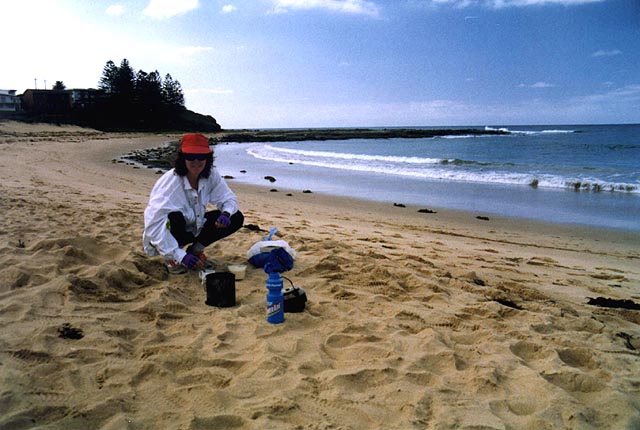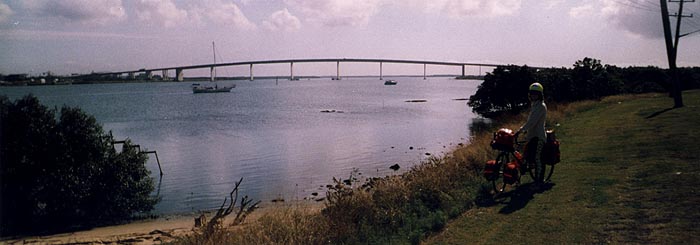|
Karen and I had no set route or itinerary to follow. The broad plan was to cycle around Australia. The more detailed plan showed a first leg from Sydney to Brisbane, and a big question mark after that. How we would accomplish those plans and what paths we would follow were unknown, to be decided as we went along. For the moment, we were simply travelling, seeing where the road led us.
At the end of each day we planned to look at our maps, check all the information we had gathered about the area we were riding through, and discuss where we would head the next day. We could go where we liked, stop when and wherever we chose, spend time at some places, bypass others. We were free.
However, we were not really appreciating this new-found freedom as we struggled for almost half an hour to ride up the hill out of Patonga. Our legs screamed at us, the first of many conversations we would have with them and with various other parts of our anatomies. At the top of Patonga Hill we eventually pulled into a lookout carpark, propped Elle and Mel against a convenient log and walked somewhat shakily to the viewing point. A family of four soon joined us to admire the scene.
"Where are you headed?" they asked.
"We're cycling around Australia."
"Fantastic! How long have you been on the road?"
"About two hours."
Our answer would sound a lot more impressive a couple of months later.
The best thing about riding up Patonga hill is coasting down the other side. Karen and I enjoyed the downhill while it lasted, taking care to avoid any bumps that could easily buckle a wheel or break spokes, axles or frames. At speed, and with the bikes carrying not only us, but an extra forty kilograms of gear as well, the force behind any bump is magnified and breaking the bike is a constant danger.
Once back down onto the flat again, we eased our way towards Wyoming. Karen had arranged accommodation for our first night at the home of friends, Penny and Bob, in a northern Gosford suburb which shares its name with the American state. Penny worked with Karen at Coca Cola, and the four of us had often met at various company social functions. We arrived at their home in the early evening with fifty kilometres showing on our cycle computers. Because this distance had been broken into two sections by the ferry trip and subsequent picnic, our legs actually felt quite okay.
We did not exactly rough it on that first night. Our hosts treated us superbly, with lovely hot showers, champagne and good conversation during dinner, and crisp, clean sheets on lovely soft beds. We would not always have luxuries such as these, and made the most of them while we could.
In the morning, after showing us around their garden and pointing out various species of birds, one of which we had not seen before (a female satin bowerbird), our hosts departed for the long commute to Sydney, leaving us with route directions out of Gosford, and a totally unexpected and very welcome packed lunch. We were soon on our way. One very large uphill not far into the day made both of us aware that our legs had not escaped unscathed from the exertions of the previous day.

Morning tea on a Central Coast beach
Gosford soon disappeared behind us, and Erina as well. We came across a sign pointing the way to the local gallery of photographer Ken Duncan, famous for his panoramic landscapes. Karen and I suddenly had a decision to make. We were obviously in no position to buy anything, and although we had long admired Ken Duncan's work, a detour of six kilometres would add significantly to the distance we rode that day. But what would be the point of travelling around Australia, we argued, if we were not prepared to go out of our way to see places of interest? We decided to establish a precedent, and turned our bikes in the direction of the gallery. It was well worth the effort.
By the time we reached Wamberal our internal fuel reserves were running low, especially for Karen who was in desperate need of a sugar fix to raise her energy levels. She is like a log fire, slow to get going, but once warmed up she powers along nicely for quite a while. Then comes the time when most of the wood has been consumed, when the flames begins to flicker and the fire dies down to smouldering embers whose bright red glow gradually fades to black, unable to be rekindled without further addition of fuel. By contrast, my metabolism can best be likened to a light bulb with an attached dimmer switch. I can flare to full brightness instantly, and adjust my output to meet whatever is demanded, switching between periods of high output and low output, with everything running smoothly, until suddenly and with great finality, the filament burns out and there is nothing more.
A banana paddle-pop icecream powered us through to the Entrance, where we lunched on Penny and Bob's sandwiches at a park bench overlooking Tuggerah Lake. An hour later we pushed on into a stiff headwind for another eleven kilometres to a caravan park in the seaside town of Norah Head, our destination for the day.
Karen walked to the local shops to get some food for dinner, while I erected the tent, inflated our thermarest mats (as comfortable as a full mattress but only an inch thick), unpacked our sleeping bags and liners, and did some maintenance on the chain-guard of Karen's bike. Thus another precedent was set. Karen shopped, I set up camp. Only once in the next three years would Karen erect the tent, and that was a couple of months later when she realised that she had better know how to do it just in case an emergency arose. As for shopping, it would become the activity most likely to prematurely end our journey, and our marriage - but more about that later.
Unfortunately, the local shops were closed and neither of us was keen to ride to other shops further afield. Dinner was a culinary failure consisting of the food we had in our panniers - baked beans and yoghurt washed down with a few cups of tea. During dinner, to take our minds off the food, we studied the stars, learning the names of the brightest ones by referring to a thin cardboard sky-chart we were carrying. Stars like Canopus, Achenar, Sirius, Rigel, Betelgeuse, Procyon, Pollux, Castor and Aldebaran would become familiar friends during the next few months as we watched their progression across the sky.
We were up at six the next morning after a very good night's rest. Karen and I are camping veterans from way back, and have spent more nights in tents than both of us care to remember. After a breakfast of muesli, we visited the local lighthouse then continued north to buy some decent food at Toukley, lunch at Swansea and reach Newcastle by mid afternoon.
The bridge overpass at Waratah Station in Newcastle will live long in our memory, because it was there we were to experience the first puncture of our journey. I crossed the overpass and was happily pedalling along after negotiating the right angled bend at the bottom when I glanced over my shoulder to see nothing but empty road behind me. Karen was nowhere to be seen. I stopped a couple of blocks away and waited, expecting Karen to come cycling around the corner at any moment, but after a couple of minutes of waiting I reluctantly turned around and began pushing my bike along the footpath back towards the overpass. Shortly after, Karen came into view, pushing her bike around the corner, a one inch nail protruding from her back tyre.
My first tyre change was not too flash. In a normal situation I could have undone the brake cable, flicked off the quick release lever, lifted the bike and removed the wheel in a matter of seconds. I had changed plenty of tyres before, but had never had to contend with the logistics of bike panniers. Not only did they turn a ten kilogram bike into a fifty kilogram monster, but they also caused problems with laying the bike down. Would we crush all of our fresh fruit and vegetables? Which side did we put the eggs in?
Eventually, after about fifteen minutes, the tyre change was complete. I had learned a few valuable lessons during that time. Remove your helmet first, because tyre changing is a hot and sweaty job. Take off your gloves, because they will get filthy. Have the spare tube ready in a convenient, easy-to-reach location and not at the bottom of a pannier where access can only be gained after removing all of the contents and scattering them around the footpath. Similarly, have soap and a towel easily accessible as well. Karen and I had not done any of those things, but we soon learned.

Stockton Bridge
North of Newcastle the Stockton Bridge rises majestically over an arm of the Hunter River. We had often crossed over it by car, admiring its grace and simplicity, but we had never ridden over it before. It turned out to be a bastard of a bridge. Narrow lanes forced speeding motorists to manoeuvre dangerously around us as we struggled up its steep flanks. It only had one narrow footpath, unreachable across four lanes of peak hour traffic, and even then protected by a metal fence along its entire length. Karen and I have cycled on city and suburban streets all our lives, but the Stockton Bridge was an ordeal quite unlike any other we had experienced, a nightmare of effort and danger.
Later in the evening I would write in our diary that the highlight of the day was getting off Stockton Bridge alive.
|

